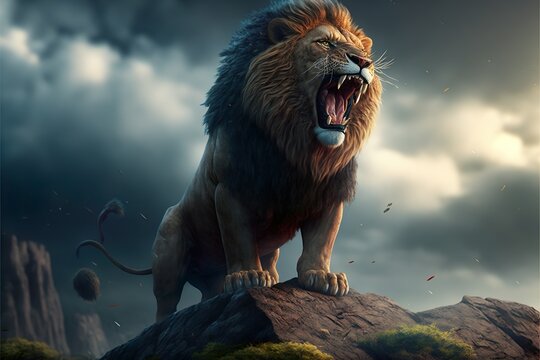zoomacademia.com – The lion, often referred to as the “King of the Jungle,” has long been a symbol of strength, power, and leadership. Despite the fact that lions primarily inhabit savannas and grasslands rather than actual jungles, this majestic animal has earned its royal title through a combination of physical attributes, social structure, and cultural symbolism. The phrase “King of the Jungle” encapsulates the lion’s dominant position in the animal kingdom and its influence in human mythology and folklore.
Physical Attributes and Strength
One of the primary reasons lions are called the “King of the Jungle” is due to their impressive physical attributes. Adult male lions are large, powerful animals with muscular bodies and powerful limbs that make them formidable predators. Male lions can weigh up to 250 kilograms (550 pounds) and reach lengths of 2.5 meters (8 feet) including the tail, making them one of the largest carnivores on land.
Their physical prowess is not limited to size and strength. Lions are highly skilled hunters, capable of taking down large prey such as zebras, antelopes, and even buffalo. While they are not the fastest animals in the savanna, their ability to stalk prey in groups and coordinate attacks makes them lethal predators.
The male lion’s iconic mane, which ranges in color from blond to black, is another feature that adds to its regal image. The mane serves multiple purposes: it makes the lion appear larger and more intimidating to rivals and helps protect the neck and head during fights. The mane’s grandeur contributes to the lion’s association with royalty and dominance.
Social Structure: The Lion’s Pride
Lions are unique among big cats in that they live in social groups known as prides. A pride typically consists of several related females, their offspring, and a few adult males. The males in the pride are often seen as protectors, guarding the group against external threats such as rival lions or other predators.
This social structure reflects the lion’s leadership qualities. While the females do the majority of the hunting, the males play a critical role in defending the territory and ensuring the safety of the pride. The male lion’s role as protector and leader mirrors the qualities of a king—providing strength and protection to his domain.
The pride’s social hierarchy also reinforces the idea of lions as rulers. The alpha male of the pride holds a dominant position, often taking control of food and mating opportunities. This leadership role within the pride is another reason the lion is perceived as a ruler, overseeing and maintaining order within its group.
Dominance in the Ecosystem
In their natural habitat, lions are apex predators, meaning they are at the top of the food chain with no natural predators. This dominant position in the ecosystem further reinforces their status as “kings.” They regulate the populations of herbivores, helping to maintain balance in the ecosystem. While they may face competition from other large predators such as hyenas, leopards, and cheetahs, lions are often the dominant force in their environment, capable of defending their kills and territories.
Their roar, which can be heard up to 8 kilometers (5 miles) away, serves as a symbol of their dominance, warning potential rivals and marking their territory. This powerful vocalization adds to the lion’s commanding presence in the wild.
Cultural and Symbolic Significance
Beyond their physical traits and ecological role, lions have been revered in human cultures for thousands of years. In ancient civilizations, lions were often seen as symbols of power, courage, and royalty. For example, in Ancient Egypt, the lion-headed goddess Sekhmet was worshipped as a deity of war and protection. Similarly, in Hinduism, the lion is associated with the god Narasimha, an avatar of the god Vishnu who took the form of a half-lion, half-human to destroy evil.
In medieval Europe, the lion was widely depicted on coats of arms, flags, and emblems, representing kingship, bravery, and nobility. This imagery cemented the lion’s role as a symbol of monarchy and leadership, which continues to be used today in royal heraldry across the world.
In literature and popular culture, lions are often portrayed as wise and noble rulers. A famous example is Aslan, the majestic lion in C.S. Lewis’s The Chronicles of Narnia, who serves as a wise and just leader in the series. Similarly, Disney’s The Lion King presents lions as rulers of the animal kingdom, with the central character, Simba, taking his rightful place as king after a journey of growth and leadership.
The Misconception: Lions and Jungles
While the phrase “King of the Jungle” has become synonymous with lions, it is somewhat of a misnomer. Lions do not actually live in jungles, as they are typically found in savannas and grasslands of Africa. The phrase likely originated from early European explorers and writers who equated tropical forests with untamed, wild environments and used “jungle” as a metaphor for any wild, untamed place.
The term may have been popularized because the lion’s image as a dominant force fits the archetype of a ruler of nature’s wild, whether it is in a jungle or savanna. Over time, the title stuck, even though it doesn’t accurately describe the lion’s natural habitat.
Conclusion
The lion’s title as “King of the Jungle” is deeply rooted in its physical strength, social leadership, and cultural symbolism. Though the name is somewhat inaccurate given the lion’s actual habitat, it remains a fitting representation of the lion’s commanding presence and its role as a top predator and leader in the animal kingdom. Throughout history and across various cultures, the lion has been admired for its strength, courage, and regal bearing—qualities that have earned it a place of honor as the “king” among animals.







